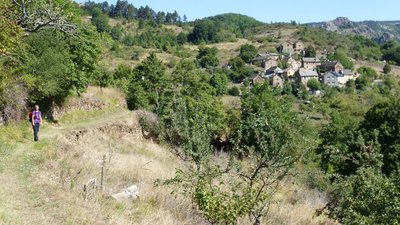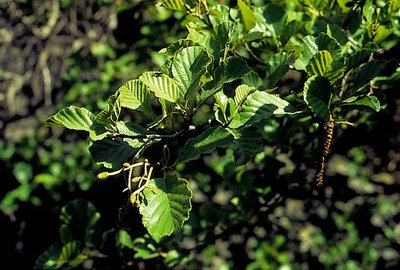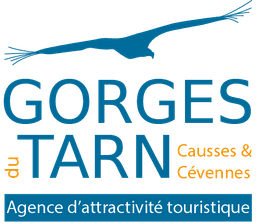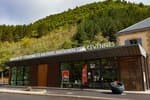
Rocher des Fées
A hike along the slope of a small, steep-sided valley (valat) and on former paved tracks, in the Cévenol part of the district. It goes through hamlets that are built in turn from limestone, schist and granite, confirming that the cristalline and limestone zones meet at Ispagnac.
5 points of interest

Chemin sur Salanson - © Nathalie Thomas  Know-how
Know-howFormer track
"The former track from Cantonnet to Salanson starts between two walls. Higher up, it is lined by a wall on the mountain side and constructed on top of a supporting wall on the valley side. On the steepest sections, you can still see the remains of the paving: the calades.” (P. Grime)
“To maintain the tracks, we did paid work on them. The 4 or 5 farmers from the village got together with a road mender from Ispagnac, who came to direct the work. We made small ditches, or a small wall, and that's how we maintained them. If we didn't work like that, we had to pay. We did three or four days a year, or twice a year. That lasted until the tracks were tarred.”
 Tradition
TraditionThe Rocher des Fées
“We were Catholics here, and there were many stories about fées (fairies). Opposite the Rock, there are piles of rocks, from a bridge built by the fairies. One day when it was -15°C here, people were coming back from Ispagnac and, at the foot of the Rock, they saw a shivering baby, a little fairy dying of cold. They took her up to their house and put her next to the fireplace. When the little fairy started to revive, they heard the mother calling her through the chimney, Fédou, Fédou, so the little fairy flew out through the chimney.”

Aulne glutineux - © Yves Maccagno  Flora
FloraAlders
"Called vergnes locally, they plunge their roots into the river because they love wet environments. This tree has a deep root system that enables it to cope with a brusque rise of the river. Its wood, reddish when cut, has long been considered evil. Once cut, it rots rapidly, but can last centuries if it is immersed in water. In the Middle Ages, it was used to make bridges. Venice is built on piles of alder and South European flowering ash. Soft and water-resistant, the wood was also used to make clogs.” (P. Grime)

Le Bramont en aval des Faux - © jean Pierre Malafosse  Water
WaterThe river Bramont
There are actually two Bramonts! The one that you are cycling along, and another Bramont, which flows north of the Cham des Bondons. As you go through Les Combettes, you are at the foot of this limestone plateau, whose highest point is at about 1,200 m. But under the plateau flows another river: the underground Bramont, discovered in 1967. It takes some of the water of the Bramont du Lot (north) and empties it into the Bramont du Tarn (south)! The old-timers knew this and understood that by blocking, unblocking or diverting the waters draining out of the northern river, they could vary the rate of flow of the resurgence.

 Architecture
ArchitecturePradines mill
This is one of the eight watermills that used to operate in the Ispagnac valley. Two were on the Tarn, the others on its tributaries. These mills produced wheat flour and chestnut flour as well as oil.
Description
Cross the D 907 bis by the pharmacy and walk left along it for 400 m, direction Florac. Take the path on the right that runs alongside the river Tarn, below the D 907 bis. Cross the road, walk alongside the large house on the left for 20 m along the road, and turn right to take the path. To begin with, this is steep. At Salanson, the path joins up with a road: turn right onto it, follow it for 750 m, and then leave it by taking the downhill path on the right. At the crossroads, take the path on the left that goes back uphill to Lonjagnes. In Lonjagnes, go down the small lane immediately on your right, which goes down between the houses to the bottom of the hamlet. Cross the small bridge and take the path on the right. At Le Marazeil, cross the footbridge and walk up the small lane to the top of the hamlet. After the carpark before the wooden cross, take the path on the right with the granite bridge, which joins up with the road. Turn right onto the road and walk to Nozières. Go uphill into the hamlet and take the second small lane on the right. This joins up with the N 106 road. 100 m before the stop sign, take a path on the right. Stay on the main path, ignoring two paths on the right. Cross the bridge, turn left, and follow the path alongside the brook to Le Cantonnet. To return to Ispagnac, cross the D road and join up with the outbound path.
- Departure : Ispagnac
- Arrival : Ispagnac
- Towns crossed : Ispagnac
Forecast
Altimetric profile
Recommandations
Shaded hike. Steep climb from Le Cantonnet to Salanson. Crosses a sheep pen between Lonjagnes and Le Marazeil (keep dogs on lead). Steep descent before arriving at Nozières bridge. Make sure your equipment is appropriate for the day's weather conditions. Remember that the weather changes quickly in the mountains. Take enough water, wear good shoes and put on a hat. Please close all gates and barriers after yourself.
Information desks
Tourism office Cévennes Gorges du Tarn, Ispagnac
Place de l'Église, 48320 Ispagnac
This office is part of the National Park's associated tourist-information network, whose mission is to provide information on, and raise awareness of, the sites and events as well as the rules that must be observed in the National Park's central zone.
Open year-round
Tourism'house and national Parc at Florac
Place de l'ancienne gare, N106, 48400 Florac-trois-rivières
This office is part of the National Park's associated tourist-information network, whose mission is to provide information on, and raise awareness of, the sites and events as well as the rules that must be observed in the National Park's central zone.
On site: exhibitions, video projections, events and shop Open year-round
Transport
- Bus line 258 “Florac – Sainte-Enimie – Le Rozier”, every day in July and August
- Bus line 252 “Ispagnac – Florac – Alès”
Access and parking
Ispagnac, carpark opposite the pharmacy
Parking :
Calculateur d'itinéraire Lio
Utilisez le calculateur liO pour organiser votre trajet en région Occitanie.
Autres régions
Calculez votre itinéraire en Auvergne Rhône Alpes sur Oùra
Biodiversité autour de l'itinéraire
Source


Report a problem or an error
If you have found an error on this page or if you have noticed any problems during your hike, please report them to us here:


